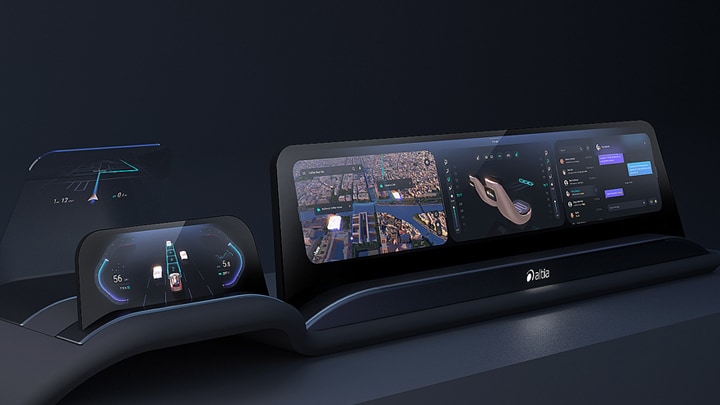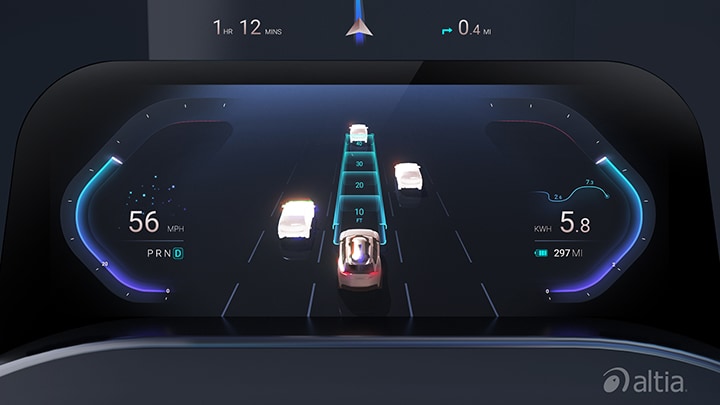We are all moving into a world where the vehicles we own and utilize will be
predominately electrified with successively more advanced autonomous
capabilities. While this transition will take time, it has already begun as
many vehicles we own or encounter today incorporate those technologies. Why is
an electric, semi- or fully-autonomous vehicle any different than other
‘traditional’ vehicles? Simple: awareness.
Being electric-powered, EVs require a driver to think a bit differently about
where to ‘get fuel’ and how much range the vehicle has left. Vehicles are
incorporating significant advances in the number of sensors they deploy, how
safety is presented to the driver and how vehicle occupants interact with the
vehicle in an ever-increasingly complex media-rich environment.
In this environment, the driver can quickly reach information overload
attempting to navigate through complex systems and status indicators from the
car. Presenting all this data to the driver and passengers in an efficient and
effective manner requires highly advanced, but easy to use human machine
interfaces.
We are delighted to have collaborated with Altia for the fourth year in a row
to showcase what is possible with NXP i.MX applications processors combined
with Altia HMI technologies, all designed to create that efficient driving
experience with next generation EVs.
 Barry Pompea, Senior Product Designer, Altia
Barry Pompea, Senior Product Designer, Altia
At CES 2022, Altia and NXP have partnered to capture a powerful moment in time
for automotive—OEMs are transitioning their cockpit designs toward autonomous
and electrified vehicles while delivering innovative new applications and
services for drivers and passengers. Visitors to CES 2022 can experience these
technologies in our Connected eCockpit—powered by Altia user interface
development software and NXP’s i.MX 8QuadMax applications processors.
Partnering for Innovation in EVs
Developing a cohesive experience for an electric vehicle cockpit brings a host
of challenges. Design teams must consider functional safety, multiple
operating systems, creating a cohesive user experience across vehicle displays
and ensuring best performance on hardware.
With EVs, there is an even greater expectation for advanced displays
throughout the vehicle – and designers must display critical system
information to the driver while still respecting the cognitive load intensive
task of safely maneuvering the vehicle. Keeping drivers apprised of power
consumption and route-adjusted range feedback eases the range anxiety common
with EVs. Anchoring the IVI experience with the Android platform enables
scalability via apps and provides a familiar user experience.
Designing for efficiency is also critical. Developers must deploy HMI code
that will optimize the capabilities of their production hardware to ensure
that maximum range is extracted from every watt.
Solutions for automotive eCockpits. Explore NXP i.MX
applications processors for eCockpit
Infotainment.
Altia and NXP Semiconductors offer a powerful combination of technologies to
build integrated cockpit designs for automotive applications. Together, we are
delivering immersive in-vehicle experiences. Our latest eCockpit demo—housed
in a production Mercedes and driven by two NXP i.MX 8QuadMax applications
processors—delivers a seamless user experience for the driver and passenger.
The graphics, powered by Altia HMI development software, reflect a cohesive
look and feel that helps improve the user experience. The C source code
generated by Altia DeepScreen optimizes the capabilities of the i.MX 8 to
ensure the best use of the vehicle’s available power.
Building Advanced HMIs with Altia and NXP
The Connected eCockpit was conceived and designed by Altia’s Professional
Engineering Services team and created using Altia Design 13. Altia’s HMI
software allows technical artists, designers and engineers the ability to
build high-performance HMIs without hand-coding graphics, resulting in rapid
time to production. The teams were able to leverage assets from 2D and 3D
design tools, making artwork import easy. Altia DeepScreen code generator then
outputs the code running on the i.MX 8QuadMax. DeepScreen supports a wide
range of NXP platforms – from low-power MCUs to high-performance applications
processors. This includes i.MX 8, i.MX 6, and i.MX crossover MCUs including
i.MX RT1052, i.MX RT1062, i.MX RT1170, S32V, MAC57D5xx, MPC5645S, MPC5606S,
i.MX28, i.MX53, LPC1788 and VFxxx.
NXP supplies the i.MX 8 platform, an applications processor which offers the
processing power to drive full dashboard HMIs at top performance. The eCockpit
includes two NXP i.MX 8 QuadMax SoCs, which come equipped with two ARM®
Cortex®-A72 cores, four ARM Cortex-A53 cores, two Arm
Cortex-M4F cores plus 64-bit LPDDR4/DDR4 DRAM.
Futuristic Features Realized for CES 2022
The Connected eCockpit demonstrates unified integration of HMI elements
between two screens— a 12.3” (1920x720) instrument cluster and 28” (3840x720)
passenger display—with state-of-the-art pillar-to-pillar graphics powered by
Altia and two NXP i.MX 8QuadMax applications processors. The eCockpit uses
multiple OS architectures with Linux® in the instrument cluster
and Android in the 4K passenger display.
 Altia eCockpit Displays
Altia eCockpit Displays
The eCockpit design follows a modern interaction paradigm inspired by mobile
phones. This was driven in part by
Jakobs Law –meaning that users expect new interfaces to behave like the ones they
already know. This unified HMI user experience embraces automotive tech
considerations including EV readouts, advanced ADAS, reconfigurable layout and
data streaming. Altia designers and developers created a UX for drivers and
passengers across the cockpit displays, serving up real-time advanced 3D
throughout.
 Altia 12.3” Instrument Cluster
Altia 12.3” Instrument Cluster
The 12.3” instrument cluster demonstrates intuitive design elements to inform
EV drivers. For example, safety particles appear above the speed readout and
accumulate with good driving, providing a gamified experience to keep drivers
safe and engaged. A power histogram visualizes the vehicle’s power output in
real-time. Additionally, active following distance assist in the center of the
cluster gives the driver helpful feedback to set a safe follow distance from
the car in front of the vehicle.
 Altia 28” (3840x720) passenger display
Altia 28” (3840x720) passenger display
The expansive 28” passenger display hosts a variety of 3D rich information
screens designed to inform and entertain. Much like the devices we use every
day, the IVI user interface includes responsive panels that allow the user to
adjust the size of each application pane. Users can drag an application pane
from one section of the display or fling it from one side to another. Apps
open intuitively from an app tray by dragging and dropping into the desired
display area. The user-adjustable vehicle settings are visualized in rich real
time 3D. Altia’s advanced IVI offers a chat application in the passenger
display only so that passengers can safely receive messages. The dynamic map
leverages Altia’s 3D capability so that users can explore while in route to
their destination. Audio entertainment is controlled via dynamic playlists and
coverflow.
Next-gen Connected eCockpit for Safer Experiences that Inform and
Entertain
Ready Today for Tomorrow
Altia and NXP are primed to bring automotive cockpits to the future—from
electrified to autonomous. The NXP i.MX 8QuadMax applications processor
revolutionizes mega-display automotive applications with a powerful feature
set for advanced HMIs. Altia’s HMI design tools and services give customers
the ability to take full advantage of the i.MX 8QuadMax processor architecture
to deliver an optimal and visually stunning eCockpit experience.
For more information about how Altia can bring your cockpit design project to
life with NXP i.MX 8 QuadMax applications processors, visit
www.altia.com
or email
info@altia.com.
For more information:
i.MX 8QuadMax Applications
Processors
Learn more about
Altia HMI development software








